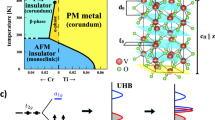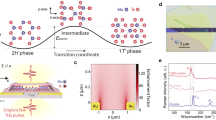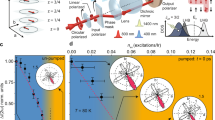Abstract
There is significant technological interest in developing ever faster switching between different electronic and magnetic states of matter. Manipulating properties at terahertz rates requires accessing the intrinsic timescales of both electrons and associated phonons, which is possible with short-pulse photoexcitation. However, in many Mott insulators, the electronic transition is accompanied by the nucleation and growth of percolating domains of the changed lattice structure, leading to empirical timescales dominated by slowly coarsening dynamics. Here we use time-resolved X-ray diffraction and reflectivity measurements to show that the photoinduced insulator-to-metal transition in an epitaxially strained Mott insulating thin film occurs without observable domain formation and coarsening effects, allowing the study of the intrinsic electronic and lattice dynamics. Above a fluence threshold, the initial electronic excitation drives a fast lattice rearrangement, which is followed by a slower electronic evolution into a metastable nonequilibrium state. Microscopic model calculations based on time-dependent dynamical mean-field theory and semiclassical lattice dynamics explain the threshold behaviour and elucidate the delayed onset of the electronic phase transition. This work highlights the importance of combined electronic and structural studies in unravelling the physics of dynamic transitions and the timescales of photoinduced processes.
This is a preview of subscription content, access via your institution
Access options
Access Nature and 54 other Nature Portfolio journals
Get Nature+, our best-value online-access subscription
$29.99 / 30 days
cancel any time
Subscribe to this journal
Receive 12 print issues and online access
$209.00 per year
only $17.42 per issue
Buy this article
- Purchase on Springer Link
- Instant access to full article PDF
Prices may be subject to local taxes which are calculated during checkout




Similar content being viewed by others
Data availability
The time-resolved X-ray reciprocal space mapping data presented in this work are available for download at Zenodo (https://doi.org/10.5281/zenodo.10373577).
References
Gorelov, E. et al. Nature of the Mott transition in Ca2RuO4. Phys. Rev. Lett. 104, 226401 (2010).
Alexander, C. S. et al. Destruction of the Mott insulating ground state of Ca2RuO4 by a structural transition. Phys. Rev. B 60, R8422–R8425 (1999).
Fürsich, K. et al. Raman scattering from current-stabilized nonequilibrium phases in Ca2RuO4. Phys. Rev. B 100, 081101 (2019).
Georges, A., Medici, L. D. & Mravlje, J. Strong correlations from Hund’s coupling. Annu. Rev. Condens. Matter Phys. 4, 137–178 (2013).
Neupane, M. et al. Observation of a novel orbital selective Mott transition in Ca1.8Sr0.2RuO4. Phys. Rev. Lett. 103, 097001 (2009).
Sutter, D. et al. Hallmarks of Hunds coupling in the Mott insulator Ca2RuO4. Nat. Commun. 8, 15176 (2017).
Liebsch, A. & Ishida, H. Subband filling and Mott transition in Ca2−xSrxRuO4. Phys. Rev. Lett. 98, 216403 (2007).
Georgescu, A. B. & Millis, A. J. Quantifying the role of the lattice in metal–insulator phase transitions. Commun. Phys. 5, 135 (2022).
Hao, H. et al. Metal–insulator and magnetic phase diagram of Ca2RuO4 from auxiliary field quantum Monte Carlo and dynamical mean field theory. Phys. Rev. B 101, 235110 (2020).
Friedt, O. et al. Structural and magnetic aspects of the metal–insulator transition in Ca2RuO4. Phys. Rev. B 63, 174432 (2001).
Riccò, S. et al. In situ strain tuning of the metal–insulator-transition of Ca2RuO4 in angle-resolved photoemission experiments. Nat. Commun. 9, 4535 (2018).
Zhang, J. et al. Nano-resolved current-induced insulator–metal transition in the Mott insulator Ca2RuO4. Phys. Rev. 9, 011032 (2019).
Nakamura, F. et al. From Mott insulator to ferromagnetic metal: a pressure study of Ca2RuO4. Phys. Rev. B 65, 220402 (2002).
Wall, S. et al. Ultrafast disordering of vanadium dimers in photoexcited VO2. Science 362, 572–576 (2018).
Lloyd-Hughes, J. et al. The 2021 ultrafast spectroscopic probes of condensed matter roadmap. J. Phys. Condens. Matter 33, 353001 (2021).
Abreu, E. et al. Dynamic conductivity scaling in photoexcited V2O3 thin films. Phys. Rev. B 92, 085130 (2015).
Singer, A. et al. Nonequilibrium phase precursors during a photoexcited insulator-to-metal transition in V2O3. Phys. Rev. Lett. 120, 207601 (2018).
Yang, D.-S., Baum, P. & Zewail, A. H. Ultrafast electron crystallography of the cooperative reaction path in vanadium dioxide. Struct. Dyn. 3, 034304 (2016).
Gray, A. X. et al. Ultrafast terahertz field control of electronic and structural interactions in vanadium dioxide. Phys. Rev. B 98, 045104 (2018).
Johnson, A. S. et al. Ultrafast X-ray imaging of the light-induced phase transition in VO2. Nat. Phys. https://doi.org/10.1038/s41567-022-01848-w (2022).
Glinka, Y. D., Babakiray, S., Johnson, T. A., Holcomb, M. B. & Lederman, D. Acoustic phonon dynamics in thin-films of the topological insulator Bi2Se3. J. Appl. Phys. 117, 165703 (2015).
Warren, B. E. X-ray Diffraction (Dover Publications, 1990).
Pashkin, A. et al. Ultrafast insulator–metal phase transition in VO2 studied by multiterahertz spectroscopy. Phys. Rev. B 83, 195120 (2011).
Han, Q. & Millis, A. Lattice energetics and correlation-driven metal–insulator transitions: the case of Ca2RuO4. Phys. Rev. Lett. 121, 067601 (2018).
Peil, O. E., Hampel, A., Ederer, C. & Georges, A. Mechanism and control parameters of the coupled structural and metal–insulator transition in nickelates. Phys. Rev. B 99, 245127 (2019).
Georges, A., Kotliar, G., Krauth, W. & Rozenberg, M. J. Dynamical mean-field theory of strongly correlated fermion systems and the limit of infinite dimensions. Rev. Mod. Phys. 68, 13–125 (1996).
Aoki, H. et al. Nonequilibrium dynamical mean-field theory and its applications. Rev. Mod. Phys. 86, 779–837 (2014).
Schüler, M. et al. NESSi: The Non-Equilibrium Systems Simulation package. Comput. Phys. Commun. 257, 107484 (2020).
Rho, H., Cooper, S. L., Nakatsuji, S., Fukazawa, H. & Maeno, Y. Lattice dynamics and the electron–phonon interaction in Ca2RuO4. Phys. Rev. B 71, 245121 (2005).
Souliou, S.-M. et al. Raman scattering from Higgs mode oscillations in the two-dimensional antiferromagnet Ca2RuO4. Phys. Rev. Lett. 119, 067201 (2017).
Jung, J. H. et al. Change of electronic structure in Ca2RuO4 induced by orbital ordering. Phys. Rev. Lett. 91, 056403 (2003).
Okamoto, H. et al. Ultrafast charge dynamics in photoexcited Nd2CuO4 and La2CuO4 cuprate compounds investigated by femtosecond absorption spectroscopy. Phys. Rev. B 82, 060513 (2010).
Okamoto, H. et al. Photoinduced transition from Mott insulator to metal in the undoped cuprates Nd2CuO4 and La2CuO4. Phys. Rev. B 83, 125102 (2011).
Lenarčič, Z. & Prelovšek, P. Ultrafast charge recombination in a photoexcited Mott–Hubbard insulator. Phys. Rev. Lett. 111, 016401 (2013).
Sensarma, R. et al. Lifetime of double occupancies in the Fermi–Hubbard model. Phys. Rev. B 82, 224302 (2010).
Schmidbauer, M., Braun, D., Markurt, T., Hanke, M. & Schwarzkopf, J. Strain engineering of monoclinic domains in KxNa1−xNbO3 epitaxial layers: a pathway to enhanced piezoelectric properties. Nanotechnology 28, 24LT02 (2017).
Boulle, A., Infante, I. C. & Lemee, N. Diffuse X-ray scattering from 180° ferroelectric stripe domains: polarization-induced strain, period disorder and wall roughness. J. Appl. Crystallogr. 49, 845–855 (2016).
Shao, Z. et al. Real-space imaging of periodic nanotextures in thin films via phasing of diffraction data. Proc. Natl Acad. Sci. USA 120, e2303312120 (2023).
Trigo, M. et al. Fourier-transform inelastic X-ray scattering from time- and momentum-dependent phonon–phonon correlations. Nat. Phys. 9, 790–794 (2013).
Zhu, D. et al. Phonon spectroscopy with sub-meV resolution by femtosecond X-ray diffuse scattering. Phys. Rev. B 92, 054303 (2015).
Gorobtsov, O. Y. et al. Femtosecond control of phonon dynamics near a magnetic order critical point. Nat. Commun. 12, 2865 (2021).
Singer, A. et al. Photoinduced enhancement of the charge density wave amplitude. Phys. Rev. Lett. 117, 056401 (2016).
Sinha, S. K., Sirota, E. B., Garoff, S. & Stanley, H. B. X-ray and neutron scattering from rough surfaces. Phys. Rev. B 38, 2297–2311 (1988).
Vitalone, R. A. et al. Nanoscale femtosecond dynamics of Mott insulator (Ca0.99Sr0.01)2RuO4. Nano Lett. 22, 5689–5697 (2022).
McLeod, A. S. et al. Nanotextured phase coexistence in the correlated insulator V2O3. Nat. Phys. 13, 80–86 (2016).
Tancogne-Dejean, N., Sentef, M. A. & Rubio, A. Ultrafast modification of Hubbard U in a strongly correlated material: ab initio high-harmonic generation in NiO. Phys. Rev. Lett. 121, 097402 (2018).
Grånäs, O. et al. Ultrafast modification of the electronic structure of a correlated insulator. Phys. Rev. Res. https://doi.org/10.1103/PhysRevResearch.4.L032030 (2022).
Baykusheva, D. R. et al. Ultrafast renormalization of the on-site coulomb repulsion in a cuprate superconductor. Phys. Rev. X, https://doi.org/10.1103/PhysRevX.12.011013 (2022).
Picano, A., Grandi, F. & Eckstein, M. Inhomogeneous disordering at a photoinduced charge density wave transition. Phys. Rev. B https://doi.org/10.1103/PhysRevB.107.245112 (2023).
Lantz, G. et al. Ultrafast evolution and transient phases of a prototype out-of-equilibrium Mott–Hubbard material. Nat. Commun. 8, 13917 (2017).
He, Z. & Millis, A. J. Photoinduced phase transitions in narrow-gap Mott insulators: the case of VO2. Phys. Rev. B https://doi.org/10.1103/PhysRevB.93.115126 (2016).
Ishikawa, T. et al. A compact X-ray free-electron laser emitting in the sub-ångström region. Nat. Photon. 6, 540–544 (2012).
Kameshima, T. et al. Development of an X-ray pixel detector with multi-port charge-coupled device for X-ray free-electron laser experiments. Rev. Sci. Instrum. 85, 033110 (2014).
Williams, G. J., Pfeifer, M. A., Vartanyants, I. A. & Robinson, I. K. Three-dimensional imaging of microstructure in Au nanocrystals. Phys. Rev. Lett. 90, 175501 (2003).
Jung, J. H. Raman scattering and optical absorption studies of an orbital ordered Ca2RuO4. Solid State Commun. 133, 103–107 (2005).
Eckstein, M. & Werner, P. Nonequilibrium dynamical mean-field calculations based on the noncrossing approximation and its generalizations. Phys. Rev. B 82, 115115 (2010).
Pelz, M. Comparison of Mott–Hubbard-transition on the Bethe-lattice and the 2D-square-lattice. Bachelor thesis, TU Vienna (2019).
Acknowledgements
The work was primarily supported by the US Department of Energy, Office of Science, Office of Basic Energy Sciences (Contract No. DE-SC0019414 for X-ray experiments and interpretation to A.V., O.G., J.P.R., J.Z.K, G.K, K.M.S. and A.S., for thin-film synthesis to H.N. and N.S., for DFT calculations to J.Z.K, G.K. and N.A.B. and for high-frequency reflectivity to R.R. and J.W.H.). A.J.M. acknowledges support from the US Department of Energy, Office of Science, Office of Advanced Scientific Computing Research, Scientific Discovery through the Advanced Computing programme (Award No. DE-SC0022088). This research was funded in part by the Gordon and Betty Moore Foundation’s EPiQS Initiative (Grant Nos. GBMF3850 and GBMF9073 to Cornell University). Sample preparation was, in part, facilitated by the Cornell NanoScale Facility, a member of the National Nanotechnology Coordinated Infrastructure, which is supported by the National Science Foundation (NSF; Grant No. NNCI-2025233). This work was also supported by the US Department of Energy, Office of Science, Office of Basic Energy Sciences (Contract No. DE-SC0001805 for temperature-dependent XRD to E.L. and O.G.S.). H.P., V.A.S. and J.W.F. acknowledge support from the US Department of Energy, Office of Science, Office of Basic Energy Sciences (Award No. DE-SC-0012375 for studying complex-oxide heterostructures with X-ray scattering). The X-ray free-electron laser experiments were performed at beamline 3 at the SPring-8 Angstrom Compact Free-electron Laser with the approval of the Japan Synchrotron Radiation Research Institute (Proposal No. 2019A8084). D.G. is supported by the Slovenian Research Agency (Programmes J1-2455, P1-0044 and MN-0016-106). K.K., V.R. and R.D.A are supported by the NSF (Grant No. DMR-1810310). The calculations were performed using a software library developed by M. Eckstein and H.U.R. Strand. The Flatiron Institute is a division of the Simons Foundation. We thank B. Gregory and Z. Shao for measuring the resistivity.
Author information
Authors and Affiliations
Contributions
A.S., D.G.S. and K.M.S. conceived the idea. O.Y.G., Y.S., R.B., Y.K. and T.T. conducted the time-resolved X-ray experiments. A.V. analysed the time-resolved X-ray data with help from J.Z.K, G.K. and A.S. D.G. and A.J.M. performed the time-resolved DMFT calculations. H.N., N.S. and J.P.R. synthesized and characterized the films with advice from K.M.S. and D.G.S. J.Z.K., G.K. and N.A.B. performed the DFT calculations. K.K., V.R. and R.D.A. conducted the low-frequency reflectivity experiments. E.L. and O.G.S. collected the temperature-dependent XRD data. V.A.S., H.P. and J.W.F. assisted in the interpretation of the X-ray data. R.R. and J.W.H. conducted the high-frequency reflectivity experiments. A.V., D.G., A.J.M. and A.S. wrote the paper with comments from all co-authors.
Corresponding author
Ethics declarations
Competing interests
The authors declare no competing interests.
Peer review
Peer review information
Nature Physics thanks Richard Haglund and the other, anonymous, reviewer(s) for their contribution to the peer review of this work.
Additional information
Publisher’s note Springer Nature remains neutral with regard to jurisdictional claims in published maps and institutional affiliations.
Supplementary information
Supplementary Information
Supplementary discussion, Figs. 1–22 and Tables 1 and 2.
Rights and permissions
Springer Nature or its licensor (e.g. a society or other partner) holds exclusive rights to this article under a publishing agreement with the author(s) or other rightsholder(s); author self-archiving of the accepted manuscript version of this article is solely governed by the terms of such publishing agreement and applicable law.
About this article
Cite this article
Verma, A., Golež, D., Gorobtsov, O.Y. et al. Picosecond volume expansion drives a later-time insulator–metal transition in a nano-textured Mott insulator. Nat. Phys. (2024). https://doi.org/10.1038/s41567-024-02396-1
Received:
Accepted:
Published:
DOI: https://doi.org/10.1038/s41567-024-02396-1
This article is cited by
-
Through the slopes of a light-induced phase transition
Nature Physics (2024)



